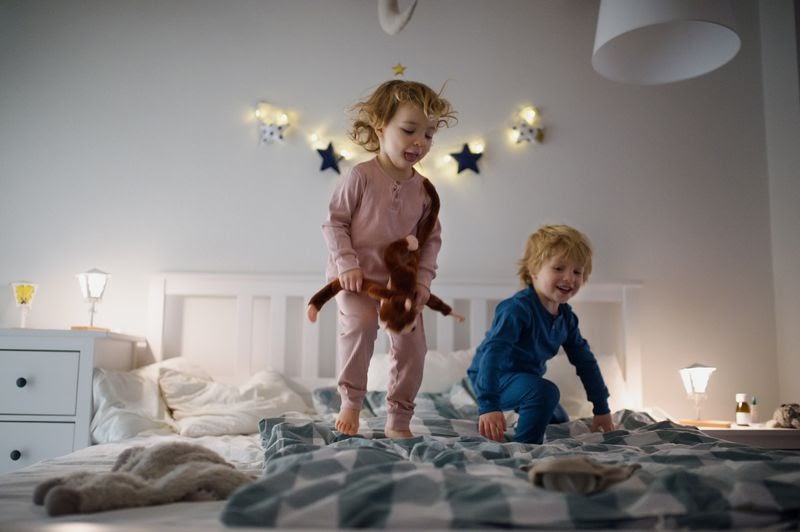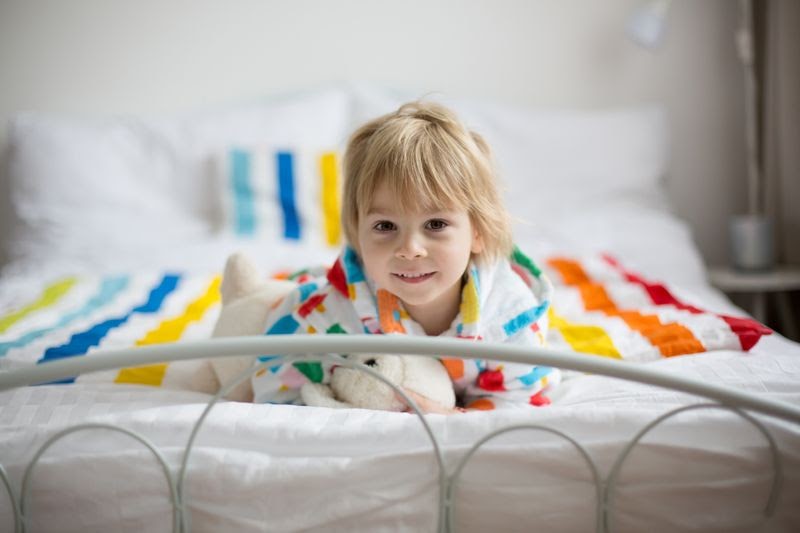
Parents have mixed feelings about their toddlers becoming more active. It’s fun to see them zooming and jumping around their bedroom. But they are also paranoid about their kids’ safety. As parents, our role begins with understanding why our toddlers behave the way they do. That way, we can allow them the gift of freedom and joy in their newfound abilities while creating an environment that allows our children to move risk-free.
To start our process of understanding, let’s dive deeper into why our kids love to move around and why they love jumping on the bed so much.
Why Do Kids Love Jumping on the Bed?
The need for your toddler to move has been there since birth. As they grow up, they start to learn movements they can do with their bodies, and the boundaries widen when it comes to what they can explore. Your curious toddler—armed with unlimited energy—will always attempt to use this ability and push their limits. This is how they develop even more control of their kinetics.
Jumping is one of the things they do that help them develop. It is instinctive at first, but if they discover it serves a purpose or yields a positive result, the behaviour is repeated. So you can’t stop them from jumping on that soft and springy bed mattress, especially if it feels great to bounce up and down.
While jumping is beneficial to your kid, they often do it in a space that poses certain risks. And the most common danger your toddler faces when jumping on the bed is head injuries.

Most Common Types of Head Injuries
Jumping on the bed is relatively safe. The whole mattress your kid is jumping on is basically a cushion that prevents injuries on the body caused by falling. If there’s anything that is exposed to risk, it’s the head. It can hit the bed’s top board, frame, or edges if your kid lands outside the mattress or falls out of balance.
Knowing the potential head injuries that can happen during a fall can help prepare you for the things you have to do as a parent. Here are some of them.
Contusions – Also known as a bruise. This head injury is easy to spot when you examine your toddler’s head. You’ll see discolored regions on the scalp that will swell up. This is because the blood starts to accumulate in the injured area. Contusions are usually mild head injuries and can heal with no doctor intervention.
Concussions – It’s a mild traumatic brain injury (TBI) from a hit on the head resulting in dizziness, ringing on the ears, and disorientation. This form of head injury, although mild, may need some monitoring because a concussion may not show any surface indication of damage.
Scalp Wounds – This injury happens when a head hits a sharp surface, like the edge of the bed frame, resulting in a cut wound. This injury will cause mild to severe bleeding on the scalp region that’s hit and will require first aid or even a trip to the emergency room, depending on the severity. After the scalp wounds heal, the scalp’s surface where the scar is will not allow hair to grow.
Skull Fractures – This is the most severe head injury and happens when there’s an intense head trauma resulting from a hard fall on a solid object. This may lead to neurological problems and requires immediate attention from a doctor.
Different injuries require different levels of treatment, but there are certain things you can do immediately after the injury to mitigate any damage.
What to Do When Your Toddler Hits Their Head
The situation that you were afraid of has happened. As parents, instead of panicking, we have to accept that the accident already happened and go on damage-control mode. Here are some of the things you can do in this situation.
Remain Calm
Keep calm so you can think clearly about the next steps to take. Your child will also be taking cues from you on what to feel about the situation. It’s best to be calm and comforting in front of your child.
Control Bleeding
Use a clean cloth and apply gentle pressure on the bleeding area of the head. Keep the pressure on until the bleeding has stopped.
Cold Compress
Get a pack of ice and put it on the swelling area to allow the bump to subside. If there’s bleeding apart from a bump, allow the bleeding to stop first.
Observe
Examine your toddler’s movement for about 1-2 hours after the incident. Talk to your child. If they seem disoriented both when talking or moving about, call a doctor.
Monitor
After doing all the necessary first aid, monitor your toddler’s behaviour within 24-48 hours. If something is off like excessive sleeping, constant vomiting, seizures, or any behavior out of the ordinary, take a trip to the emergency room.

Childproof Your Toddler’s Bedroom
To prevent any mild or severe injuries altogether, it’s better to be prepared so the worst doesn’t happen. Head injuries aren’t exclusively happening on the bed. It can happen in the entire child’s bedroom. So childproof it by doing the following:
Secure Tall Furniture
Tall furniture like drawers is attractive for toddlers to climb on. And if the furnishing’s weight is not evenly distributed as your kid climbs up, it can tip over and fall on their head. So make sure you keep your drawer stable by making it firmly planted on the wall.
Lock and Seal
In the case of drawers, your kid can pull them out and use them as a ladder to climb on top of the furniture. The higher your toddler is, the greater the risk of falling and getting head injuries. So lock the drawers. Also, lock everything that can be opened for additional safety.
Cover Electrical Outlets
Electrical outlets may be unrelated to head injury, but it can still pose a risk to your toddler. Your toddler’s fingers are small enough that they can fit inside the holes of electrical sockets. Make sure it’s covered with electrical tape if not in use, so your toddler’s curiosity doesn’t lead to electrocution.
Place Toys on the Ground
A huge part of what makes kids curious is toys. If they see one on top of furniture or a bed, they will, at some point, try to go and get it. So be sure to place all toys on the ground to discourage any climbing and jumping movement.
Pad Sharp Edges of the Bed
The sharp edges are the ones that cause severe head injuries that bleed. Soften the edges by getting bed frame corner protectors. Note that some bed frame corner guards can also be used for furniture with sharp corners.
The Benefits of Ashtonbee’s Bed Frame Corner Guards
Ashtonbee has a high-quality bed frame corner protector that you can use to cushion the edges of the bed. Here are some of the benefits you can get from the product.
Absorbs Impact well
The metal bed frame corner guards have a thick round profile on the outer surface designed to absorb impact and drastically reduce any violent hit on your toddler’s head. This prevents the risk of head concussions, scalp wounds, and even skull fractures.
Doesn’t Damage the Bed Edges
There are corner guards that can damage the bed’s edges simply because the fit isn’t too great. With Ashtonbee’s Corner Guards (Clear), you’ll be able to check if it fits perfectly and readjust accordingly.
FDA Approved
The materials used for Ashtonbee’s corner guards are non-toxic and hypoallergenic. It is safe enough for your child and is approved by regulators.
Adaptable
The corner guards are not just exclusive to bed edges. It can be used for other edges as well. You can use it for your tables, chairs, and drawers. You can buy several and install in it all of your furniture edges to childproof not only your toddler’s bedroom but the entire house.
Childproofing Essentials With Ashtonbee
If you want to go beyond the bedframe’s edges and provide overall bedroom safety for your child, you can count on Ashtonbee to provide you with the right things. Apart from corner guards, you can double up with bedside rails that prevent your child from falling on the floor while they jump on the bed.
Discover more safety products when you visit Ashtonbee’s site today.


